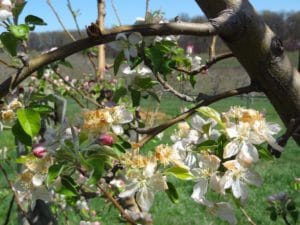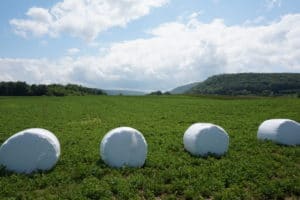Climate Smart Farming (Part 2)
Getting a Leg Up on Climate Change
by Jonathan Lambert & Abbie Kramer
From increased flooding and short-term drought, to heat stress and unexpected freeze risk, the effects of climate variability and change are exacerbating the challenges that farmers already face on a daily basis. Climate change presents an unprecedented test for the ingenuity of farmers throughout the world, whose main goal is to produce high quality food, feed and fiber, while protecting the environment, paying living wages and remaining profitable. These goals will become increasingly challenging when one factors in the need to sustainably increase agricultural production in order to feed an increasing population, given the increasingly variable and extreme changes in global climate. In order to achieve all of these goals, farmers, scientists, extension educators, and policy makers must all work together to formulate innovative solutions that not only mitigate (lessen) climate change and its effects on agriculture, but also help reduce risks and increase resiliency (adaptation) to climate change.
Previously in Part One of our Climate Smart Farming series (Summer 2016, available online https://smallfarms.cornell.edu/2016/07/05/climate-smart-farming/) in the article “Climate Smart Farming: How is the Changing Climate Affecting Your Farm?” we discussed issues such as heat stress and flooding that are affecting farms today, and outlined the climate change impacts that are expected in the future for the Northeast. As a follow-up to part one, this article provides an overview on the tools, resources, and practices that can be used to better predict and manage these challenges and get a leg up on extreme weather and climate impacts.
Climate Change & Agriculture Tools & Information
In order to effectively stay ahead of the curve, farmers need the most accurate information on the changes that are occurring. Organizations such as the Cornell Climate Smart Farming (CSF) Program, the National Oceanic and Atmospheric Association (NOAA), and regional climate centers such as the Northeast Regional Climate Center (NRCC), provide useful climate and weather-based information that can be used to monitor current and projected weather and climate conditions to give farmers a better idea of how to stay ahead of the game and manage their climate risk.
The Cornell CSF Program was launched in 2015 to give farmers information on how the climate is changing, best management practices, and to support implementation of on-farm mitigation and adaptation strategies. Through the program, farmers can take advantage of a toolkit of resources to assist with decision-making, a specialized CSF Extension team for personal advice and climate-based recommendations, an interactive online farmer forum for Q&A, video tutorials and testimonials, and state-of-the-art climate-based agricultural decision tools. The CSF Program also collaborates with organizations such as the USDA Northeast Climate Hub and NRCC, and encourages the use of resources and information from other organizations such as NOAA and the US Drought Monitor.
Strategically Using Climate Data and Tools
With such a wealth of climate change and agriculture information, it may seem overwhelming for farmers to figure out how to respond in a strategic and productive way. By pinpointing the key risks to your farm, however, the CSF program can help farmers identify specific solutions to reduce risk, as highlighted below:
Short-term Drought: One of the biggest challenges for farmers in the Northeast this summer was the severe drought in much of the region – short-term drought is exacerbated by climate change through warmer temperatures, increased evapotranspiration, and longer intervals between rainfall events. While many farmers will be able to determine for themselves that abnormally dry conditions are occurring, tools such as the U.S. Drought Monitor can help farmers examine the level of short-term drought they are currently experiencing, and allow farmers to put this in a regional/national perspective. In order to make specific on-farm changes to mitigate and respond to short-term drought, farmers can also use the CSF Water Deficit Calculator/Irrigation Scheduler, which helps to determine the optimum frequency and duration of water necessary to avoid plant stress, given your location, crop type, soil texture, and the current and forecasted climatological conditions. Once farmers are armed with this information, they can think about utilizing best management practices to increase resiliency. For growers, these would include increasing irrigation capacity or improving irrigation efficiency, working to build up soil health and utilizing cover crops to hold water in the soil, and experimenting with drought-tolerant crop varieties.
Warmer and Longer Growing Seasons: Another significant challenge (or opportunity) faced by farmers in the Northeast today is the fact that growing seasons are getting longer and warmer. NOAA data indicates that, on average, the Northeast sees 10 days more per year without frost than it did in the middle of the 20th century. Some crops may not respond well to higher temperatures, but this combination of longer seasons and higher temperatures may also allow for new varieties of crops to be planted, or more crops to be planted within a year. In order to visualize and adapt to this change, farmers can utilize the CSF Growing Degree Day (GDD) Calculator, which plots accumulated GDD (a measure of heat accumulation throughout the growing season) alongside climatological average GDD accumulations, and also makes a 6-day projection for GDD accumulation at the end of the graph. This allows farmers to optimize planting and harvesting dates based on GDD accumulation. In addition to the CSF GDD Calculator, farmers can get a feel for whole season projections through maps like the NOAA Seasonal Outlook on Temperature/Precipitation. This map provides a projection and description of climate variations on timescales from weeks to seasons, allowing farmers to see the probability of below average, average, and above average precipitation and temperature for a desired range of time, and plan accordingly.
Freeze Risk: In the past few years, late season freezes have struck orchards and vineyards after plants have already began to bloom, causing serious crop losses, and this year in particular, an April freeze devastated entire peach orchards. With climate change, freeze events are not receding as fast as the first warm days are advancing, bringing elevated freeze risk to the Northeast. Because of this, the CSF Program is developing freeze risk tools for grapes and apples that will take into account chill requirements, species, location, and the current climatological conditions. The extra hours or days of notice provided by these tools will allow growers sufficient time to take mitigative measures such as putting out heating devices, fans, and covers to protect from damaging temperatures. With these tools, farmers will be able to better plan for the transition points in the growing season.
Important Takeaways
We have not exhausted the list of climate impacts and solutions for the Northeast United States in this article, but have given specific examples that can serve as building blocks and templates for other issues such as flooding, heat stress, and pest/disease pressures. Each of these issues has its own strategy/solution that accompanies it that is based on an assessment of the specific risks to your farm. For additional support though, the USDA is developing a comprehensive new framework for climate risks and adaptation strategies, which should be finalized in 2016. In the meantime, your local Cornell Cooperative Extension (CCE) or Soil and Water Conservation District (SWCD) staff, and the Climate Smart Farming Extension Team, can serve as resources as well.
Jonathan Lambert is a staff member with the Climate Smart Farming Program at the Cornell Institute for Climate Smart Solutions (CICSS) in Ithaca, NY. Abbie Kramer provided support as a 2016 summer intern for CICSS.
For more information:
With greater access to resources, experts, and prediction tools for further insight into climate variability, farmers have a unique opportunity to both adapt to and help mitigate climate change, while raising their bottom line. For more information, see the following sites:
– www.climatesmartfarming.org
– www.climatesmartfarming.org/climate-smart-farming-extension-team/
– www.nrcc.cornell.edu/
– https://www.climatehubs.usda.gov/hubs/northeast



